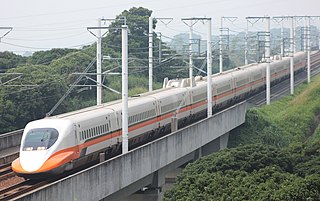
The THSR 700T is the high-speed electric multiple unit trainset derived from the Japanese Shinkansen family for Taiwan High Speed Rail (THSR), Taiwan's high-speed rail line. The THSR 700T is based primarily on the 700 Series Shinkansen that currently operates on the San'yō Shinkansen line and previously on the Tokaido Shinkansen line in Japan, with the "T" referring to Taiwan. The trains were manufactured in Japan by Kawasaki Heavy Industries, Nippon Sharyo, and Hitachi, Ltd., marking the first time Japanese Shinkansen trains have been exported overseas. 30 trains were delivered to THSR operator Taiwan High Speed Rail Corporation (THSRC), and are in regular service with a top speed of 300 kilometres per hour (186 mph) since the line's opening on January 5, 2007.
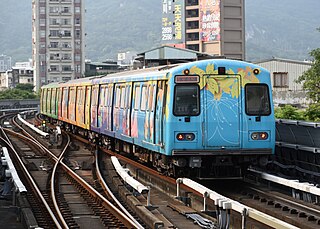
The Taipei Metro Xinbeitou branch line is an elevated, high-capacity branch line of the Tamsui–Xinyi line. It first opened for service on 28 March 1997. The line is 1.2 km (0.75 mi) long and consists of two stations.

Taipei Main Station is a major metro and railway station in the capital Taipei, Taiwan. It is served by Taipei Metro, the Taiwan High Speed Rail, and Taiwan Railway. It is also connected through underground passageways to the terminal station of Taoyuan Airport MRT and the Taipei Bus Station. It is the busiest station in Taiwan and one of the busiest stations in Asia, with more than 5,000 trains arriving and departing daily; on average, more than 600,000 people use Taipei Main Station every day.

The Pingtung Line is a line of the Taiwan Railway Administration West Coast line in Taiwan.

Kaohsiung Main Station is a railway and metro station in Sanmin District, Kaohsiung, Taiwan served by the Taiwan Railways and Kaohsiung Rapid Transit. It is one of four special class stations, the highest class with the most services. It is currently undergoing reconstruction, scheduled to be complete in 2024.

The Shalun Line is a branch line of the Taiwan Railways Administration (TRA) West Coast line in Tainan, Taiwan. It was built to link the Western Line to the Taiwan High Speed Rail (THSR) Tainan Station, speeding up transit times between downtown Tainan and the THSR station, with services running from Nanke railway station or Tainan TRA station to Shalun Station, next to the THSR station. The line opened on January 2, 2011.

The Puyuma Express is a type of railway service on Taiwan Railway (TR) notable for using tilting trains. It began commercial service on 6 February 2013 during the Spring Festival.
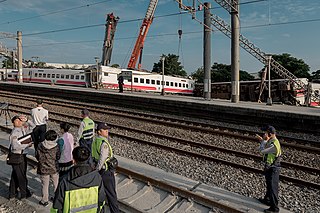
On 21 October 2018, a passenger train derailed in Yilan County, Taiwan, killing 18 people and injuring 187. At the time, it was Taiwan's deadliest rail accident since a collision near Miaoli in 1991 that killed 30 people.
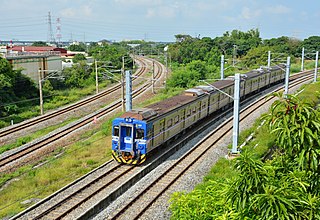
The Chengzhui line is a line of the Taiwan Railways Administration connecting the Taichung line at Chenggong station to the West Coast line at Zhuifen station, forming a wye. Currently, only local services run through the Chengzhui Line, make a direct connect between stations on Mountain line and stations on Coastal line and 11.8 km shorter of travel route and without needed to transfer at Changhua station, saving about 10 minutes travel time and waiting time while transfer at Changhua station.

The Green line is a rapid transit line in Taichung as part of Taichung Metro. The line was briefly opened to the public on 16 November 2020, but closed on 22 November due to faulty couplers on the trains. The line officially re-entered service on 25 April 2021, becoming Taiwan's fifth rapid transit system in operation. Two extensions, one heading east to Dakeng and the other reaching south into Changhua, are also planned.
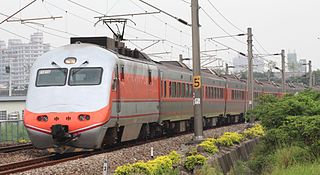
The E1000 locomotive, commonly known as the PP Tze-chiang, is a series of electric push-pull trains used by the Taiwan Railways Administration (TRA), operated as part of the Tze-chiang limited express service. The locomotives were built by Union Carriage & Wagon and GEC-Alsthom, while the passenger cars were built by Hyundai Precision & Industries and Tang Eng Iron Works.

The EMU900 series is a series of electric multiple unit passenger trains owned by Taiwan Railway (TR). Manufactured in South Korea by Hyundai Rotem, the trains are used on Local and Fast Local services, which stop at most stations. They entered service on 6 April 2021.

The EMU600 series is a series of electric multiple unit passenger trains operated by Taiwan Railways Administration (TRA). The trains are built as local trains and are used throughout the island’s rail network.

The Future is an excursion train operated by the Taiwan Railways Administration (TRA) that is composed of refurbished Chu-Kuang Express rolling stock. As of November 2020, the train only operates if reserved in advance. The Future began services on 31 December 2020.

The EMU1200 series is a series of electric multiple unit passenger trains operated by Taiwan Railways Administration (TRA). The train was originally known as the EMU200 series until all of its cars were refurbished between 2002 and 2004. It is one of the trains that are used for the Tze-Chiang Limited Express.
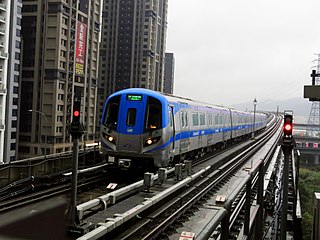
The Taoyuan Metro 1000 series, also referred to as Commuter Trains, are the electric multiple unit train types that are used for the all-stop Commuter services on the Taoyuan Airport MRT.

On 2 April 2021, at 09:28 NST (01:28 UTC), a Taroko Express train operated by the Taiwan Railways Administration (TRA) derailed at the north entrance of Qingshui Tunnel in Heren Section, Xiulin Township, Hualien County, Taiwan, killing 49 people and injuring at least 200 others. At the time of the accident, the train was carrying 494 passengers. The eight-carriage train derailed after colliding with a construction truck that had fallen down a slope onto the tracks north of Hualien City; the train came to rest in the tunnel, with severe damage and many casualties. The train incident was primarily due to human factors and was preventable, as an investigation from The New York Times, revealed that it was "systemic failures at a government agency" including "a culture of complacency and weak oversight", that had made the disaster possible.

The Taoyuan Metro 2000 series, also referred to as Express Trains, are the electric multiple unit train types that are used for the limited-stop Express services on the Taoyuan Airport MRT.

The EMU3000 series is a series of electric multiple unit trains operated by the Taiwan Railway (TR). The trains are built by the Japanese company Hitachi Rail as inter-city trains and entered passenger service on 29 December 2021.




















